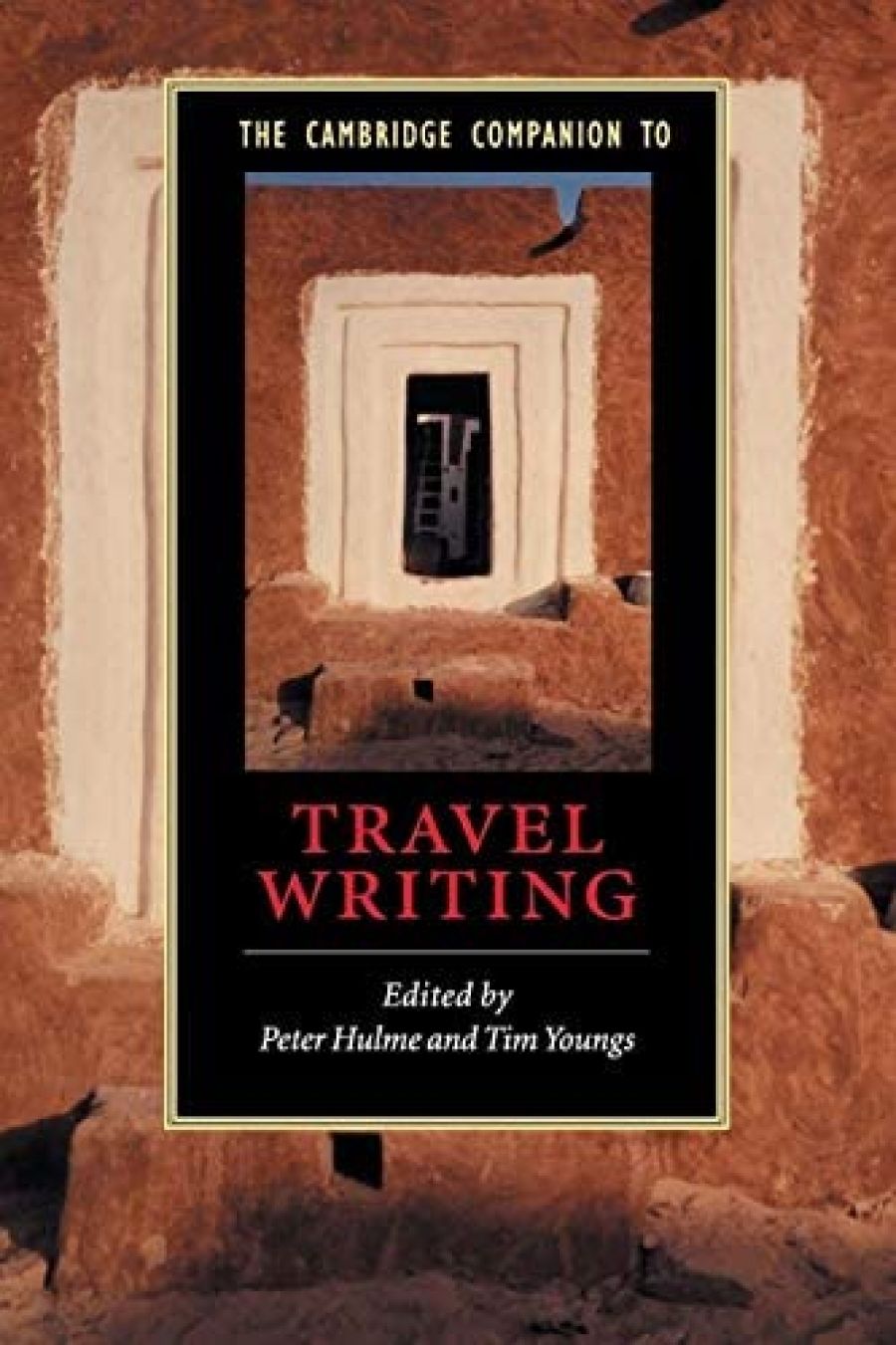
- Free Article: No
- Contents Category: Travel
- Review Article: Yes
- Article Title: Universal nomads
- Online Only: No
- Custom Highlight Text:
In our postmodern age, when everything travels and travel is a metaphor for everything, travel and travel writing have become the subject of intense scholarly interest and debate. Travel, once largely the domain of geographers, and travel writing, previously relegated to the status of a sub-literary genre, now engage attention from literary studies, history, anthropology, ethnography, and, most fruitfully, from gender and postcolonial studies. Conferences and publications abound.
- Book 1 Title: The Cambridge Companion to Travel Writing
- Book 1 Biblio: CUP, $49.95 pb, 353 pp
- Book 2 Title: Venus in Transit
- Book 2 Subtitle: Australia’s women travellers
- Book 2 Biblio: FACP, $24.95 pb, 363 pp
- Book 2 Cover Small (400 x 600):

As Mary Baine Campbell points out in her essay on travel writing and its theory, the emergence of travel and travel writing as a major area of scholarly endeavour is closely linked to decolonisation and the consequent mass movement of peoples. The founding text for the contemporary study of travel and travel writing was Edward Said’s Orientalism (1978), just as it was for postcolonial studies, and a great deal of the theoretically informed investigation of travel writing relates to the age of imperialism. Much of recent commentary on imperialism and decolonisation has been based on the recovery and analysis of people’s writing about the ‘foreign’ and the ‘exotic’ places in which they travelled and lived – colonial masters, ambivalent wives, explorers and alienated modern artists. But, as Carr in her essay on Modernism and Travel, and Billie Mellman in hers on the Middle East/Arabia suggest, Said’s paradigm, and arguments such as those of Mary Louise Pratt on the complicity of travel writing in the imperialist project, are now being questioned, modified, and nuanced as scholars seek out the diversity, anxieties, and ambivalence in their travellers’ tales.
Feminist scholarship has resulted in the recovery and dissemination of travel writing by women and the production of ‘an alternate history of free and mobile women actors’. Analysis of women’s travel writing in the Empire has complicated the problem of the relationship of women to colonialism as well as that of women’s history. The central question – if and how women’s travel writing differs from that of men – is not only one that has eluded an answer but also one of receding relevance. At the conclusion of her essay on Gender and Travel, Susan Bassnett emphasises the enormous diversity of women’s travel writing and its resistance to simple categorisation.
Issues such as the problematic relationship of women to postcolonialism do not complicate the ambiguously titled Venus in Transit: Australia’s women travellers 1788–1930. I had assumed that the subject would be the travels of Australian women, but Venus in Transit is an anthology of writing about Australia by British women who visited or resided for a time in the colonies. The collection includes extracts from the published diaries, letters, and travel memoirs of unknown convict women, a ladies’ maid, wives of British officials in Australia, writers Rosita Forbes and Angela Thirkell, journalist Flora Shaw, singer Emily Soldene, painter Marian Ellis Rowan, and aviator Amy Johnson. If the title is ambiguous, so too is Australia. The continent appears as only the briefly mentioned final destination in a number of the extracts: sailing near the Barrier Reef is as close as Forbes gets to Australia; a page on Perth is the only Australia in Thirkell’s ‘Unorthodox Impressions of an Itinerant Parent’; and ninety per cent of the extract from a speech by Amy Johnson on her 1930 flight from Britain to Australia describes the journey across the Middle East and Asia, although the Australian ten per cent does include a laconic reference to crash landing in Brisbane.
The writing on Australia covers the pioneering experience, rough travel in the outback, much freely given opinion on indigenous Australians and some lynx-eyed ethnography on the manners and mores of colonial society, and particularly on the lives, deportment, dress, and housekeeping of its female members. Among the more lively and original observers is Lady Ida Margaret Poore, daughter of the Lord Bishop of Limerick and wife of Sir Richard Poore, who observed Sydney from Admiralty House while her husband was the Royal Naval Commander-in-Chief in Australia from 1908 to 1911. Australian women received full marks from this upper-class British visitor: ‘freaks, frights and frumps’ were very rare.
Venus in Transit does contain much fascinating material, but the reader is given little help in locating or interpreting the women’s observations. The biographical introductions to the women are very brief, and there is no attempt to link their observations and experiences to current debates on women travellers or to the considerable body of writing on British visitors to Australia. The overriding impression from the anthology is that its subjects were ‘lady travellers’ and the exceptional women of what Susan Bassnett characterises as pioneering, but now outdated, approaches to the study of women and travel. Venus in Transit takes its place alongside studies with such titles as Spinsters Abroad, Ladies on the Loose and The Blessings of a Good Thick Skirt.
The journey and its story have from the time of the first record been structured in terms of departures, liminal periods of passage, and destinations – from home to home, from home to exile, from exile to home. The structure assumes a fixed home and a fixed destination. In her concluding essay, Mary Baine Campbell challenges the relevance of the archetypal model in the age of globalisation, transnational and transregional communities, and permanent nomadism. What resonances do they have in the lived experience of the vast majority of people now moving across the world?


Comments powered by CComment